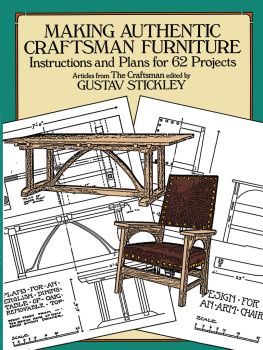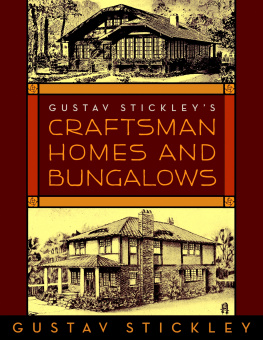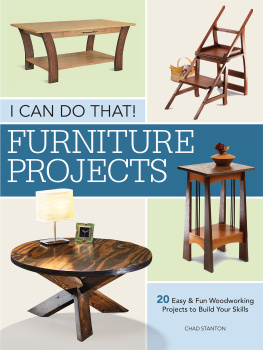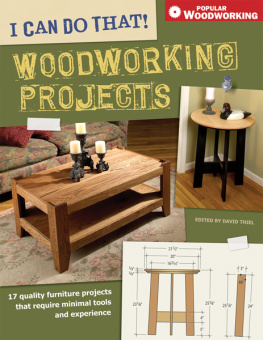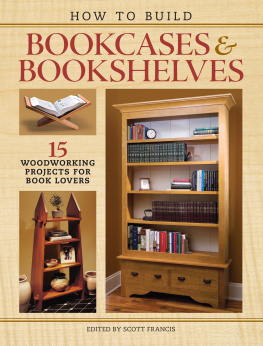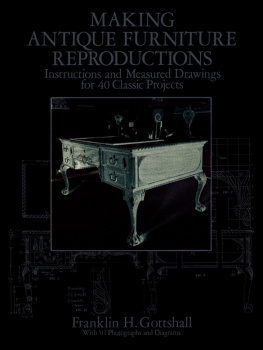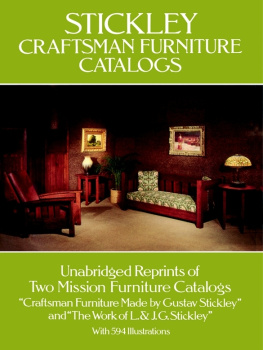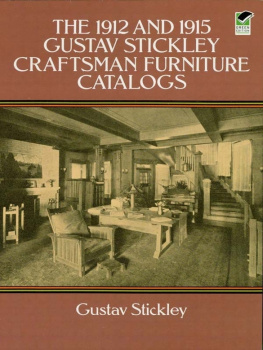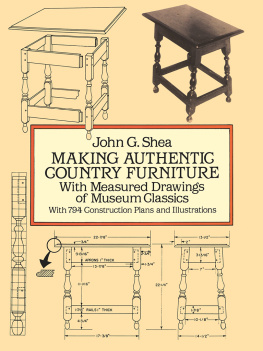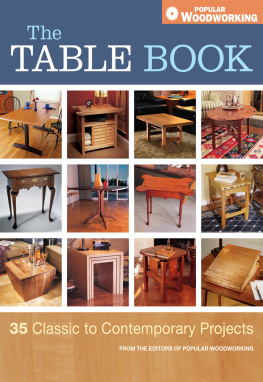MAKING AUTHENTIC
CRAFTSMAN FURNITURE
Instructions and Plans for 62 Projects
Articles from The Craftsman
edited by
GUSTAV STICKLEY

DOVER PUBLICATIONS, INC., NEW YORK
Copyright 1986 by Dover Publications, Inc.
All rights reserved.
Making Authentic Craftsman Furniture: Instructions and Plans for 62 Projects, first published in 1986, is a selection of articles from The Craftsman magazine, edited by Gustav Stickley and published from 1901 to 1916. The articles reprinted here originally appeared in the following issues of The Craftsman: page 1, May 1905; , September 1907.
Library of Congress Cataloging in Publication Data
Main entry under title:
Making authentic craftsman furniture.
Articles from The Craftsman, edited by Gustav Stickley and published between 1901 and 1916.
1. Furniture making. I. Stickley, Gustav, 18581942. II. Craftsman (Albany, N.Y.)
TT194.M351986684.10485-13075
ISBN-13: 978-0-486-25000-7 (pbk.)
ISBN-10: 0-486-25000-8 (pbk.)
Manufactured in the United States by Courier Corporation
25000815
www.doverpublications.com
Publishers Note
This book contains instructions and plans for making sixty-two pieces of authentic Craftsman furniture. The projects are reprinted directly from Gustav Stickleys important magazine, The Craftsman, published from 1901 to 1916. Plans for furniture were a regular feature of The Craftsman; the projects reprinted here (with one exception) first appeared in the twenty-part series Home Training in Cabinet Work, which ran in about two out of every three monthly issues between March 1905 and September 1907. (The series was followed by other, shorter series such as Lessons in Practical Cabinet Work and Lessons in Practical Cabinetmaking and Metal Work.)
In addition to their intrinsic merit as pleasing and useful domestic objects, the pieces shown here exemplify a pivotal development in American decorative arts. Although related to the work of William Morris and the Arts and Crafts Movement in England, as witness the Morris chair included here, Stickleys publication developed a unique style. The simple, straightforward Craftsman approach to furniturerelatively unornamented pieces with clean, functional linesbecame a classic American style in its own right. (For further information on Craftsman furniture, see Stickley Craftsman Furniture Catalogs, Dover 23838-5.)
Each project reprinted here generally includes the following: a brief statement of the items character, including suggestions for appropriate varieties of wood; a mill bill giving complete lumber specifications; schematic drawings or diagrams of the piece, showing both front and side views with dimensions; a perspective drawing of the completed piece. An Index of Projects appears on page .
Contents
A FOOT REST
T HIS piece of furniture is designed for a foot rest, but might find plenty of use in a house, especially in a bedroom, where it could be used for a slipper stool. Its construction needs no further explanation than is apparent from the drawing. The wood could well be one of the harder variety: oak, chestnut, mahogany or mapleeither fumed or stained. The seat cover could be of leather or tapestry fastened with brass, copper or iron nails. For a section showing the method of upholstering, attention is called to the plans of the desk chair shown on .


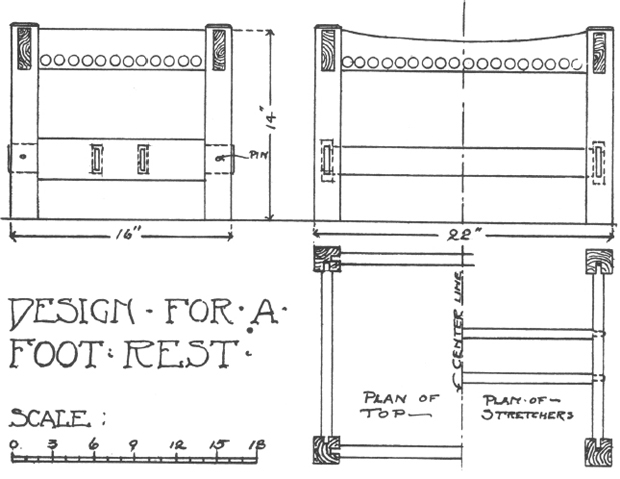
A Mans Dressing Cabinet
O NE seldom finds a more simple, convenient object of household use than the mans dressing cabinet here illustrated, which combines the functions usually filled by two or three pieces, by uniting them into a compact whole. The cabinet has the additional advantages of being pleasing in appearance, and so simple in construction that any craftsman may easily build it, in accordance with the subjoined directions.

The dimensions of the piece are fifty-four inches in height by thirty-six inches wide and twenty-four inches deep, with a framing of seven-eighth inch stuff, as indicated, and with one-half inch panels. The doors are provided with strap-hinges, and, on the inside, are lettered with such inscriptions as may suit the fancy of the individual builder.
The large, topmost drawer, running the entire length of the piece, is five inches deep, and is designed for a general utility place. The small upper drawer at the right, is fitted, like a change-drawer, with six saucer-like divisions for shirt, collar, and sleeve buttons, and other small objects which are easily lost. Behind lies a space for handkerchiefs. This drawer, the one beneath it, and the two on the left are five inches deep.
The compartments in the center of the cabinet and those which are beneath the small lateral drawers pull out. Their dimensions are ten and one-half by ten inches.

The two large trays at the bottom are used, the one for shoes, and the other for trousers. The space thus afforded, permits the garments to be laid aside without folding at the knee.
By this device, as well as by the other provisions of the cabinet, all folding and rumpling of clothing are obviated. Furthermore, when the doors are opened, the wardrobe lies ready for use : a saving of time which will be appreciated by the hard-working business or professional man of many engagements, for whom a minute saved is sometimes a fortune gained.
CHILDS ARM CHAIR
I N building this chair put all together excepting the arms, and when the glue is dry the arm dowells are fitted and the back ones shoved into place; then, by pressure, the front will spring into its proper position. All dowells are well glued, and the glue is warmed before using. Attention is called also to the joining of the seat rails, also the three-eighths of an inch cut from the bottom of the back post after the chair is put together. This makes a little slant back to the seat, and gives a comfortable posi-to the sitter. The back slats of the chairs are slightly curved. This is done by thoroughly wetting or steaming the wood and pressing it into shapethen allowing it to dry. The accompanying drawing will illustrate a device for this purpose, which for the amateur is quite as practical as a steam press.


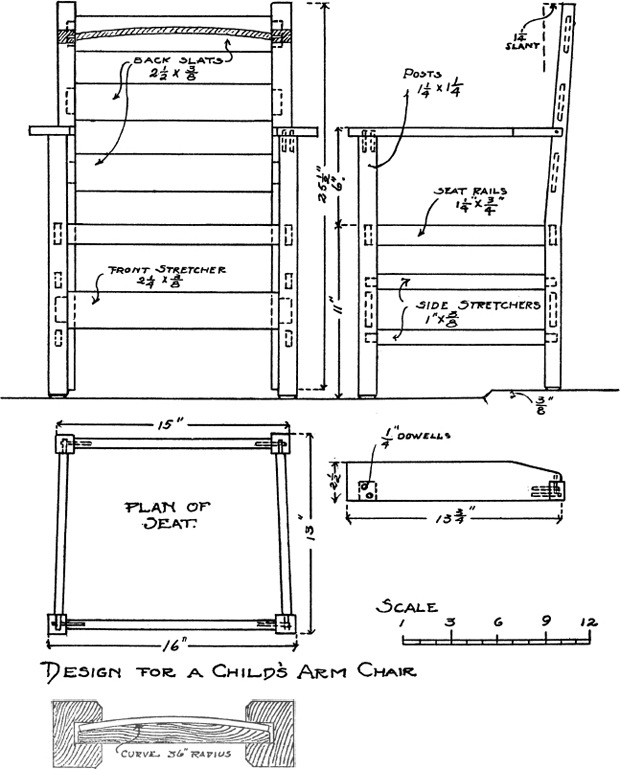
TWO DESIGNS FOR TABOURETS
T HESE pieces are almost identical in construction, yet differ in size and shape of the top. Either one would be a useful addition to almost any room for the purpose of holding a jardiniere, while the larger one might be used as a small tea table.
Next page
